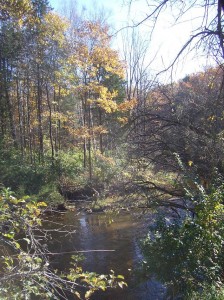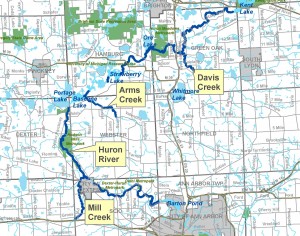
What is a Stream Buffer?
A buffer is a strip of undisturbed native vegetation bordering a stream or river or wetland.
Why stream buffers are important
If the Huron River and its tributaries could talk, one of the first things they might say to us is “Hey, can we get a little privacy here, please?” One of life’s bare necessities is clothing and shelter to keep us safe, healthy, and protected from the elements. For a stream or river, the vegetated zones along its banks, known as buffers, are the equivalent of the walls of our houses or the clothes on our backs.
Establishing buffers that protect the river, its streams, floodplains, wetlands, and steep slopes, is critical to protecting and maintaining the Huron River’s physical, biological, and chemical integrity.
The trees, shrubs and plants, and grasses in the buffer provide a natural and gradual transition from terrestrial to aquatic environments. These areas are critical for wildlife habitat. They store water during periods of high water flow and protect lakes and rivers from pollutants.
How Stream Buffers are Threatened
Many of the Huron’s stream and river corridors have been stripped of natural vegetation and replaced with turfgrass, seawalls, concrete rubble, boulders, or other artificial barriers that sever the critical connection between land and water. The eventual result is bank erosion and an accessible path for pollutants to flow directly into our waterways.
Removing buffer vegetation also fundamentally changes the way a stream flows. A buffer acts as a sponge, soaking up runoff from rainstorms and slowly releasing it to the stream. Removing or altering buffers allows runoff to rush quickly and directly into streams during rainstorms, which can dramatically harm a stream’s ecological and physical health.
What we can do to protect our rivers and streams
Watershed communities such as Green Oak Charter Township and Scio Township have adapted the HRWC Model Ordinance and enacted their own protective ordinances.
Residents and businesses |
|
| Waterfront Wisdom for Shoreline Property Owners | Natural Rivers District: Special Restrictions for these shorelines |
 |
 |
| Waterfront Homeowners, strengthen your shoreline to reduce pollution and prevent the spread of invasive species | Do you live along one of the colored lines on this map? The State of Michigan Natural Rivers Program mandates certain development restrictions that are specific to the Huron River. The Huron River and its tributaries are public domain, and are subject to public trust protection. Learn if the restrictions apply to your land. |
Local Governments: Enact an ordinance to protect and restore buffers in your own community |
|
| Model Ordinance for Stream Buffers | USDA NRCS (MI) Technical Guide for Forested Buffers. |
See more about the roles that local, state, and federal governments have in regulating water resources.
HRWC studied buffers in the watershed for two years and prepared a summary and recommendations in 2008: Report on Stream Buffers in the Huron River Watershed.



